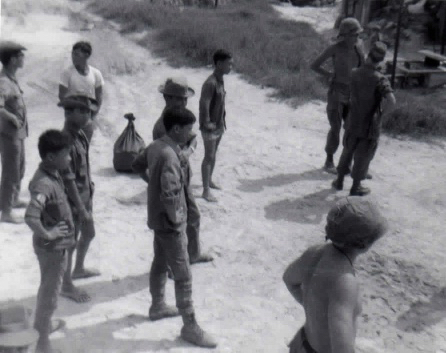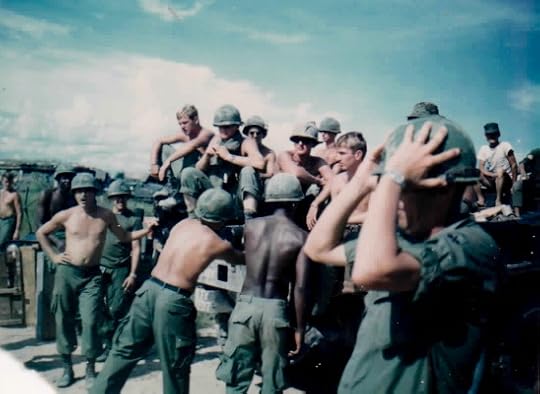Dick Graham – PLL Clerk – Part Four
Definition of Bad
When you’re in a war situation you can get close to people in a very short period of time. You’re on guard duty together; you work together; you’re in stressful situations together. It seemed like Rik Groves and Paul Dunne and I became really close.
I have very little memory of that summer, but I have some memory of the August 12 attacks. I had just gone over to motor pool and was visiting my old Gun 2 buddies, helping out with a fire mission when the mortars hit. Paul Dunne was wounded in the arm, and Rik got a lot of shrapnel in his back. I remember him asking me how bad he was hurt. I remember saying to him, “It all depends on what your definition of bad is.” It appeared to me he had a massive amount of pock marks.
I then remember going over to Stanley and yelling “Medic.” When Doc came over he pronounced him dead. I’ll never forget Doc and me picking him up to carry him away. He was so heavy! We carried him over to near the medics’ hooch near an open area where the Medevac helicopters came in.
Back on Gun 2 I sat down in the chair the phone operator used. I was light headed and I remembered to stick my head down between my knees so I wouldn’t pass out. It had a significant effect on me! Out loud I said this expression we used to help us cope with the stress. “Fuck it. It don’t mean nothin’.” We used that a lot, even though that kind of language was not part of my vernacular as I was growing up. We used that term for a lot of different situations. Basically it was to help you cope with negative emotions often for things that did mean a lot. If you got into a fight with somebody, of if your commanding officer told you to do something you thought was stupid, you just kind of did it and said it to yourself. It was a way of dealing with your emotions. What it did for me was it stuck things down. It sort of desensitized my emotions. Some guys rationalized the casualties as being “their time to go.”
The next night Gun 3 got hit and Pyle died and the whole crew was taken out. I was ordered to man an M-60 machine gun on top of the main ammo bunker. We had gun ships flying around, and Spooky up in the air with the mini guns flew around for a long time. That night I thought for sure I was going to die.
Gun 2 was hit in the early morning hours of August 12. Gun 3 was hit late the next night, but the same calendar day.
A Twisting Tale
Shortly after Gun 3 got hit, we had some Army Rangers in the area and the First Cav. Their job was to find out who was hitting us with mortars. When they didn’t seem to have any success, these Navy Seals, five of them maybe, they came into the battery. I remember talking to one of the guys. He’d been in Vietnam for seven years. I thought, how’s this guy going to be able to live once he gets back to the United States? They were dressed like VC, in black pajamas and with Ho Chi Minh racing slicks. The first night they were out they found the guys who were hitting us and things got quiet for awhile.
Dick’s memory of these few events triggered in Hank Parker, First Sergeant Durant and Andy Kach a chain of recollections. It’s a great example of how a detail in one guy’s story triggers other people in a kind of chain reaction, resulting in a wandering narrative typical of how things happened in Vietnam. Often small details don’t agree from story to story, but that’s not important, because every guy’s story is true to him.
Hank Parker, Executive Officer:
“I am glad Dick remembered this incident because I had forgotten about it.
“We were kind of numb during that period of heavy casualties (summer of 1969). We had been doing our own patrols in that area because the infantry wasn’t giving us support and we had been raising hell with our command. Hey, we’ve got the Q-4 counter mortar radar, we’re doing crater analysis, we know where these guys are at. Why aren’t you coming out here supporting us? Apparently they did and did not tell us. They may have figured because we had an ARVN (South Vietnamese) unit with us that if they told us the word would get to the ARVNs and then out to the VC. It wasn’t speculation. When I was out with the 3/506 we had an occasion where the battalion commander said the ARVNs need mortar rounds. I remember my platoon lieutenant saying hell no, these guys have enemy within their ranks so why would we give them our mortars? The battalion commander said because I am ordering you to. So we gave them three or four mortar rounds, and that night guess what? We got them back. Only they did not know to pull the safety pins and the mortars landed without exploding. Had they pulled the pins they probably would have killed us. But they did not pull the pins and we knew then that the ARVNs had some VC with them. The lieutenant went in and raised hell with the battalion commander and I thought he was going to get court martialed.
“I talked to the First Sergeant Durant and he remembers. We had movement just in front of the tree line so we did a sector fire, and the next thing we know FDC is calling CHECK FIRE, CHECK FIRE. We’ve got an American unit out there that had not been plotted. I called the tanker on our perimeter and the tank sergeant said, ‘Let’s shine a light on them.’ When the search light went on I remember them standing up waving their arms frantically. ‘Don’t shoot, don’t shoot.’
“When it got light they came into our perimeter with their prisoners and they were wearing black pajamas like their VC prisoners. I am not exactly sure what unit they were. We had the 3/506 Curahees of the 101st Airborne and I think the 2nd/1st Cav at that time too. The 101st had LRRPs (Long-Range Reconnaissance Patrol), so it could have been them. Then again I remember that we had Special Forces in Phan Thiet and I would bet they would have donned black pajamas for this kind of operation as opposed to rangers or LRRPs.
“They brought in something for the guys to look at, and Andy Kach took pictures of all the guys up on the truck crowded around so you can’t tell what it is – and I don’t remember. Then a command helicopter and a Chinook came in and picked them up with their prisoners.”
 ARVNs Looking On
ARVNs Looking On
Pictures Courtesy Andy Kach
Andy Kach, Ammo Section:
“A group dressed like Viet Cong walked out of the tree line in front of Tower Two, about three hundred meters out. We had our M-60 machine gun trained on them, and were waiting for clearance to fire. They were not in a free fire zone, so we were waiting for clearance to shoot. By now half the battery was out on the perimeter watching. When they were half way to the wire these guys started waving wildly, and we got word that they were five Special Ops guys bringing in prisoners. I guess it finally dawned on them to let us know who they were. Helicopters were on their way to pick them up, and by the time they got to the chopper pad the helicopters were coming in. It was all pretty quick.
“That’s when Hank took two guns, 5 and 6, out to the perimeter and fired on the riverbed. That’s also when Hank and five other guys got the notion one night to sneak out through the wire by the main gate to test the readiness of the battery for a ground attack.”
Hank Parker:
“After that we were still pissed off that the access road was getting mined. The infantry wasn’t coming out to support us to get them. So Cerda said let’s go get them ourselves. He pulled out his black pajamas and said let’s go out there and have a little ambush on the road.
“I always wondered where Chief Cerda got his black pajamas to put on that night. They were wearing black PJs and that’s probably where Chief Cerda got his black pajamas. One of those guys must have given them to Cerda.
“So First Sergeant Durant, Chief Cerda and myself go out by Tower One at the entrance and we start wiggling our way through the wire, and Cerda got his butt caught on the wire and tripped a flare. The tower guard swings his M-60 around ready to shoot and Cerda starts yelling, “Don’t shoot, don’t shoot. It’s me, Chief Cerda!” All this was after too many beers. First Sergeant says it’s the dumbest goddamn thing we ever did.”




